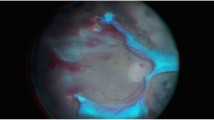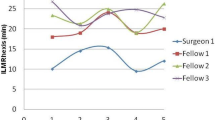Abstract
Purpose
Although latency has been cited as a disadvantage of the three-dimensional heads-up display (3D HUD) visualization system for vitreoretinal surgery, there have been no publications evaluating the effect of latency on surgical performance.
Methods
Thirty participants conducted two tasks (external suturing and inner limiting membrane peeling) on a 3D HUD at 4 levels of latency: 50 ms (ms), 68 ms, 92 ms, and 122 ms. The task completion time was measured and patients answered a subjective questionnaire on usability.
Results
No difference in completion times was found between different levels of latencies in either task. Regarding usability, significant decreases were found at 122 ms for both the suturing and peeling task overall, but for experienced HUD users, there was less of a decrease.
Conclusion
This study is the first to evaluate the effect of latency on 3D HUD for vitreoretinal surgery. The levels of latency in the current models of 3D HUD are unlikely to contribute to a decrease in surgical performance and usability with current technologies which have a latency of 70 ms.




Similar content being viewed by others
References
Riemann CD (2011) Machine vision and vitrectomy: three-dimensional high definition (3DHD) video for surgical visualization in vitreoretinal surgery. In: Woods AJ, Holliman NS, Dodgson NA (eds) San Francisco Airport, California, USA, p 78630K
Eckardt C, Paulo EB (2016) Heads-up surgery for vitreoretinal procedures: an experimental and clinical study. Retina 36:137–147. https://doi.org/10.1097/IAE.0000000000000689
Taffinder N, Smith SG, Huber J et al (1999) The effect of a second-generation 3D endoscope on the laparoscopic precision of novices and experienced surgeons. Surg Endosc 13:1087–1092. https://doi.org/10.1007/s004649901179
Zhou J, Xu H, Liang C et al (2015) A comparative study of distinct ocular symptoms after performing laparoscopic surgical tasks using a three-dimensional surgical imaging system and a conventional two-dimensional surgical imaging system. J Endourol 29:816–820. https://doi.org/10.1089/end.2014.0759
Adam MK, Thornton S, Regillo CD et al (2017) Minimal endoillumination levels and display luminous emittance during three-dimensional heads-up vitreoretinal surgery. Retina Phila Pa 37:1746–1749. https://doi.org/10.1097/IAE.0000000000001420
Zhang Z, Wang L, Wei Y et al (2019) The preliminary experiences with three-dimensional heads-up display viewing system for vitreoretinal surgery under various status. Curr Eye Res 44:102–109. https://doi.org/10.1080/02713683.2018.1526305
Kunikata H, Abe T, Nakazawa T (2016) Heads-up macular surgery with a 27-gauge microincision vitrectomy system and minimal illumination. Case Rep Ophthalmol 7:265–269. https://doi.org/10.1159/000452993
Chhaya N, Helmy O, Piri N et al (2018) Comparison of 2D and 3D video displays for teaching vitreoretinal surgery. Retina Phila Pa 38:1556–1561. https://doi.org/10.1097/IAE.0000000000001743
Romano MR, Cennamo G, Comune C et al (2018) Evaluation of 3D heads-up vitrectomy: outcomes of psychometric skills testing and surgeon satisfaction. Eye 32:1093–1098. https://doi.org/10.1038/s41433-018-0027-1
Talcott KE, Adam MK, Sioufi K et al (2019) Comparison of a three-dimensional heads-up display surgical platform with a standard operating microscope for macular surgery. Ophthalmol Retina 3:244–251. https://doi.org/10.1016/j.oret.2018.10.016
Fabrizio MD, Lee BR, Chan DY et al (2000) Effect of time delay on surgical performance during telesurgical manipulation. J Endourol 14:133–138. https://doi.org/10.1089/end.2000.14.133
Anvari M, Broderick T, Stein H et al (2005) The impact of latency on surgical precision and task completion during robotic-assisted remote telepresence surgery. Comput Aided Surg Off J Int Soc Comput Aided Surg 10:93–99. https://doi.org/10.3109/10929080500228654
Kim T, Zimmerman PM, Wade MJ, Weiss CA (2005) The effect of delayed visual feedback on telerobotic surgery. Surg Endosc 19:683–686. https://doi.org/10.1007/s00464-004-8926-6
Rayman R, Croome K, Galbraith N et al (2006) Long-distance robotic telesurgery: a feasibility study for care in remote environments. Int J Med Robot Comput Assist Surg MRCAS 2:216–224. https://doi.org/10.1002/rcs.99
Perez M, Quiaios F, Andrivon P et al (2007) Paradigms and experimental set-up for the determination of the acceptable delay in telesurgery. Conf Proc Annu Int Conf IEEE Eng Med Biol Soc IEEE Eng Med Biol Soc Annu Conf 2007:453–456. https://doi.org/10.1109/IEMBS.2007.4352321
Lum MJH, Rosen J, King H et al (2009) Teleoperation in surgical robotics – network latency effects on surgical performance. In: 2009 Annual International Conference of the IEEE Engineering in Medicine and Biology Society. pp 6860–6863
Xu S, Perez M, Yang K et al (2014) Determination of the latency effects on surgical performance and the acceptable latency levels in telesurgery using the dV-Trainer(®) simulator. Surg Endosc 28:2569–2576. https://doi.org/10.1007/s00464-014-3504-z
Perez M, Xu S, Chauhan S et al (2016) Impact of delay on telesurgical performance: study on the robotic simulator dV-Trainer. Int J Comput Assist Radiol Surg 11:581–587. https://doi.org/10.1007/s11548-015-1306-y
Kumcu A, Vermeulen L, Elprama SA et al (2017) Effect of video lag on laparoscopic surgery: correlation between performance and usability at low latencies. Int J Med Robot 13:e1758. https://doi.org/10.1002/rcs.1758
Williams GA (2017) Surgical viewing; do you see what i see? Retina Phila Pa 37:1219. https://doi.org/10.1097/IAE.0000000000001721
Marescaux J, Leroy J, Gagner M et al (2001) Transatlantic robot-assisted telesurgery. Nature 413:379–380. https://doi.org/10.1038/35096636
Rosa AM, Miranda ÂC, Patrício MM et al (2017) Functional magnetic resonance imaging to assess neuroadaptation to multifocal intraocular lenses. J Cataract Refract Surg 43:1287–1296. https://doi.org/10.1016/j.jcrs.2017.07.031
Funding
Funding was in part provided by a grant from Alcon, Inc. The authors had complete and independent control of the data and manuscript.
Author information
Authors and Affiliations
Corresponding author
Ethics declarations
Ethical approval
All procedures performed in studies involving human participants were in accordance with the ethical standards of the University of Toronto and with the 1964 Helsinki declaration and its later amendments or comparable ethical standards.
Informed consent
Informed consent was obtained from all individual participants included in the study.
Conflict of interest
Dr. Ta Kim and Dr. Chow are consultants for Alcon.
Additional information
Publisher's note
Springer Nature remains neutral with regard to jurisdictional claims in published maps and institutional affiliations.
Rights and permissions
About this article
Cite this article
Ta Kim, D., Chow, D. The effect of latency on surgical performance and usability in a three-dimensional heads-up display visualization system for vitreoretinal surgery. Graefes Arch Clin Exp Ophthalmol 260, 471–476 (2022). https://doi.org/10.1007/s00417-021-05388-6
Received:
Revised:
Accepted:
Published:
Issue Date:
DOI: https://doi.org/10.1007/s00417-021-05388-6




